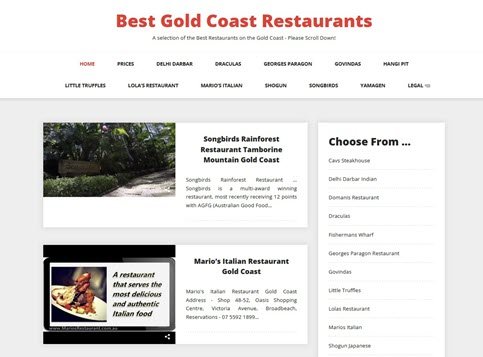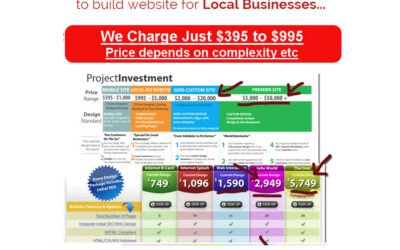The Ultimate Guide to Setting up a WordPress Website – Key Elements of Successful Web Design
Setting up a WordPress website is an exciting endeavour that allows you to establish an online presence for your business or personal brand. With its user-friendly interface and vast array of customization options, WordPress has become the go-to platform for website design. In this comprehensive guide, I will walk you through the key elements of successful web design using WordPress, from choosing the right theme to customizing your website design. Whether you are a beginner or an experienced website owner, this guide will provide you with valuable insights to create a professional and visually appealing website.
Financing Options
You can buy your website outright – but that puts a big dent in your Cashflow. Many of our clients are now choosing our RENT TO BUY option. This allows you to pay over 24 months, allowing you to start generating Income that can pay for your website. For either option, the cost is determined by what you want – Ring Terry on 0468 420 470 to discuss your needs and we will quote you.
Choosing the right WordPress theme for your website
The first step in setting up a WordPress website is selecting the right theme. A theme determines the overall look and feel of your website, including the layout, color scheme, and typography. When choosing a theme, consider the purpose of your website and the target audience. Are you creating a blog, an e-commerce site, or a portfolio? Look for a theme that aligns with your goals and provides the necessary features and functionality. Additionally, ensure that the theme is responsive, meaning it adapts to different screen sizes, as mobile-friendly design is crucial for user experience and search engine optimization.
Once you have narrowed down your options, take the time to preview and test the themes. Look for a theme that is visually appealing and easy to navigate. Pay attention to the customization options, as you may want to personalize the theme to suit your brand. Consider the support and documentation provided by the theme developer, as reliable support can save you time and frustration in the long run. By selecting the right theme, you lay the foundation for a visually stunning and user-friendly website.
Enhancing your website with WordPress plugins and widgets
One of the advantages of using WordPress is the extensive library of plugins and widgets available to enhance the functionality of your website. Plugins are software extensions that add specific features to your WordPress site, such as contact forms, social media integration, and search engine optimization tools. Widgets, on the other hand, are small elements that can be added to sidebars or other widgetized areas to display additional content or functionality.
When choosing plugins and widgets for your website, consider the specific needs of your business or brand. Do you require an e-commerce plugin to sell products? Are you looking to integrate social media sharing buttons? Research the available options and read reviews to ensure that the plugins and widgets are reliable and regularly updated. However, be cautious not to overload your website with unnecessary plugins, as they can slow down your site’s performance. Select the ones that provide essential functionality and align with your website goals.
Optimizing your website for search engines
To ensure that your WordPress website reaches its full potential, it is essential to optimize it for search engines. Search engine optimization (SEO) involves various techniques to improve your website’s visibility and organic traffic. By implementing SEO strategies, you can increase your chances of ranking higher in search engine results pages and attract more visitors to your site.
Start by conducting keyword research to identify the phrases and terms relevant to your website. Use these keywords strategically in your website content, including headings, titles, and meta descriptions. Make sure your website has a clear and logical structure, with easy navigation and user-friendly URLs. Optimize your images by using descriptive filenames and alt tags. Additionally, create high-quality and engaging content that provides value to your visitors.
Regularly monitor your website’s performance using analytics tools and make necessary adjustments to improve your SEO efforts. By optimizing your WordPress website for search engines, you can increase its visibility and reach a wider audience.
Securing your WordPress website from threats and attacks
Website security is of utmost importance to protect your WordPress website from threats and attacks. With the increasing number of cyber threats, it is crucial to take proactive measures to secure your website and safeguard your data.
Start by choosing a reliable and reputable web hosting provider that offers robust security features. Keep your WordPress installation, themes, and plugins up to date, as developers often release security patches and updates to address vulnerabilities. Implement strong passwords and consider using two-factor authentication for added security. Regularly backup your website to ensure that you can restore it in case of any unforeseen incidents.
Consider installing security plugins that provide additional layers of protection, such as firewall, malware scanning, and login protection. These plugins can detect and prevent unauthorized access to your website, as well as block malicious activities. By prioritizing website security, you can build trust with your visitors and protect your valuable data.
Creating high-quality content for your website
Content is the heart and soul of any successful website. By creating high-quality and engaging content, you can attract and retain visitors, establish your expertise, and drive conversions. When developing content for your WordPress website, consider the needs and interests of your target audience.
Start by conducting thorough research on your chosen topic and provide unique and valuable insights. Structure your content with headings and subheadings to improve readability and navigation. Use relevant keywords strategically throughout your content, but avoid keyword stuffing, as it can negatively impact your search engine rankings.
Incorporate visual elements, such as images, videos, and infographics, to make your content more engaging and shareable. Ensure that your content is well-written, free of grammatical errors, and formatted properly. By consistently creating high-quality content, you can establish your website as a trusted resource and attract a loyal audience.
Managing and maintaining your WordPress website
Once your WordPress website is up and running, it is important to regularly manage and maintain it to ensure optimal performance and security. Regularly update your WordPress core, themes, and plugins to take advantage of the latest features and security patches. Remove any unused themes or plugins to reduce the risk of vulnerabilities.
Monitor your website’s performance using analytics tools to identify any issues or bottlenecks. Optimize your website’s loading speed by compressing images, enabling caching, and minifying CSS and JavaScript files. Regularly backup your website to protect against any data loss or unforeseen incidents.
Stay informed about the latest trends and developments in web design and technology to ensure that your website remains competitive and up to date. By actively managing and maintaining your WordPress website, you can provide a seamless and satisfying user experience.
Customizing your website design with themes and templates
WordPress offers a wide range of customization options to make your website design unique and visually appealing. Apart from choosing a theme, you can further customize your website design using themes and templates.
Themes allow you to change the appearance of your website without altering its underlying structure. You can customize various elements, such as fonts, colors, backgrounds, and layouts, to match your branding and personal preferences. Consider using child themes to make customizations while still preserving the ability to update the parent theme.
Templates provide pre-designed layouts for specific pages or sections of your website. They offer a quick and efficient way to create and customize content, such as landing pages, contact forms, or blog post layouts. Utilize templates to streamline your design process and maintain consistency across your website.
Experiment with different customization options, but remember to keep your design clean, intuitive, and user-friendly. By customizing your website design, you can create a visually stunning and memorable online presence.
Key elements of successful website design
Successful website design encompasses various elements that work together to create an exceptional user experience. Consider the following key elements when designing your WordPress website:
- Visual Appeal: A visually appealing website attracts and engages visitors. Use high-quality images, balanced color schemes, and clean layouts to create a visually pleasing design.
- User-Friendly Navigation: Ensure that your website is easy to navigate, with clear menus and logical structure. Use breadcrumbs, search functionality, and intuitive navigation bars to help users find what they are looking for.
- Mobile-Friendly Design: With the increasing use of mobile devices, it is crucial to have a responsive design that adapts to different screen sizes. Test your website on various devices to ensure optimal user experience.
- Clear Call-to-Action: Guide your visitors towards desired actions by using clear and compelling call-to-action buttons or links. Make sure they stand out and are easily accessible.
- Fast Loading Speed: Optimize your website’s performance by reducing page load times. Compress images, enable caching, and optimize code to improve loading speed.
- Consistent Branding: Maintain consistency across your website by using consistent branding elements, such as logos, colors, and typography. This creates a cohesive and professional look.
- Accessibility: Ensure that your website is accessible to all users, including those with disabilities. Use alt tags for images, provide captions for videos, and make your content readable for screen readers.
By incorporating these key elements into your website design, you can create a memorable and user-friendly experience for your visitors.
Conclusion: Building a successful WordPress website
Setting up a WordPress website involves various key elements that contribute to its success. From choosing the right theme and plugins to optimizing for search engines and securing your website, each step plays a crucial role in creating a professional and visually appealing online presence. By creating high-quality content, managing and maintaining your website, and customizing your design, you can enhance user experience and drive conversions. Remember to incorporate the key elements of successful website design, such as visual appeal, user-friendly navigation, and clear call-to-action, to create a memorable and impactful website. With the guidance provided in this ultimate guide, you are well-equipped to embark on your journey of building a successful WordPress website.
Please feel free to ring me, Terry, on 0468 420 470 for a Free, No Obligation chat about your website project. We can advise you on issues covered in this report or discuss Payment Terms if you prefer to have us do it all for you.




0 Comments